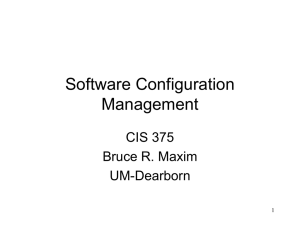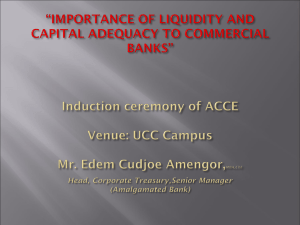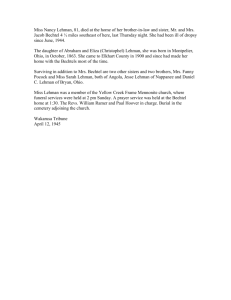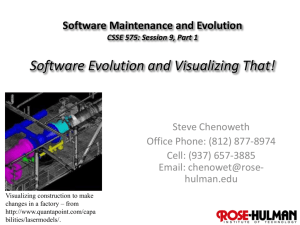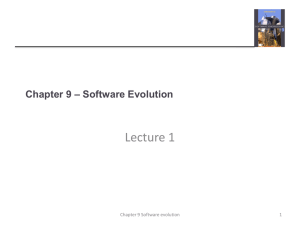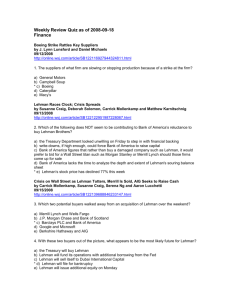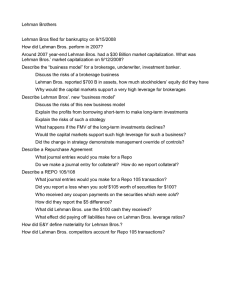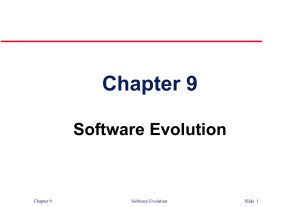Maintenance And SCM ppt
advertisement
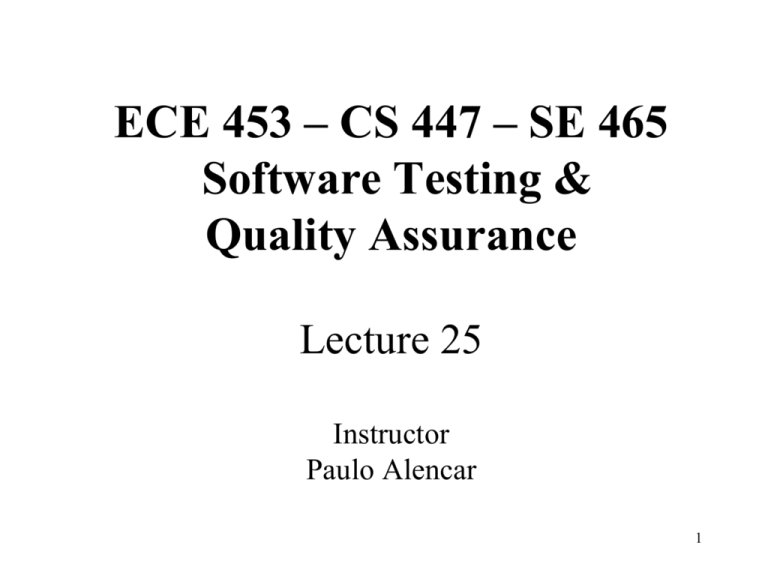
ECE 453 – CS 447 – SE 465 Software Testing & Quality Assurance Lecture 25 Instructor Paulo Alencar 1 Overview Software Maintenance and Evolution Definitions Evolution Dynamics Software Maintenance 2 Terminology Software Evolution – a continuous change from a lesser, simpler, or worse state to a higher or better state. Software Maintenance – consists of the activities required to keep a software system operational and responsive after it is accepted and placed into production. 3 Objective • To explain why change is inevitable if software systems are to remain useful • To discuss software maintenance and maintenance cost factors • To describe the processes involved in software evolution • To discuss an approach to assessing evolution strategies for legacy systems 4 Software Change • Software change is inevitable – – – – – • New requirements emerge when the software is used; The business environment changes; Errors must be repaired; New computers and equipment is added to the system; The performance or reliability of the system may have to be improved. A key problem for organisations is implementing and managing change to their existing software systems. 5 Importance of Evolution • Organizations have huge investments in their software systems - they are critical business assets. • To maintain the value of these assets to the business, they must be changed and updated. • The majority of the software budget in large companies is devoted to evolving existing software rather than developing new software. 6 Spiral Model of Evolution 7 Evolution Dynamics • Program evolution dynamics is the study of the processes of system change. • After major empirical studies, Lehman and Belady proposed that there were a number of ‘laws’ which applied to all systems as they evolved. • There are sensible observations rather than laws. They are applicable to large systems developed by large organisations. Perhaps less applicable in other cases. 8 Lehman’s Laws • • • • • • • • The Law of Continuing Change (1974) The Law of Increasing Complexity (1974) The Law of Self Regulation (1974) The Law of Conservation of Organizational Stability (1980) The Law of Conservation of Familiarity (1980) The Law of Continuing Growth (1980) The Law of Declining Quality (1996) The Feedback System Law (1996) Source: Lehman, M., et al, “Metrics and Laws of Software Evolution—The Nineties View,” Proceedings of the 4th International Software Metrics Symposium (METRICS '97), IEEE, 1997. 9 Lehman’s Laws Law Description Continuing change A program must change or become progressively less useful Increasing complexity As program changes, its structure becomes more complex Extra resources are required. Large program evolution System attributes, (eg, size, time between releases) is ~invariant for each system release. Organizational stability A program’s rate of development is ~constant. Conservation of familiarity The incremental change in each release is ~constant. Continuing growth The functionality has to continually increase to maintain user satisfaction. Declining quality Quality of systems appear to be declining unless adapted to changing environments Feedback system Evolution processes involve feedback systems for product improvement 10 Applicability of Lehman’s Laws • Lehman’s laws seem to be generally applicable to large, tailored systems developed by large organisations. – • Confirmed in more recent work by Lehman on the FEAST project It is not clear how they should be modified for – – – – Shrink-wrapped software products; Systems that incorporate a significant number of COTS components; Small organisations; Medium sized systems. 11 Software Maintenance ‘When the transition from development to evolution is not seamless, the process of changing the software after delivery is often called software maintenance’. (Sommerville, 2004) • Maintenance involves extra process activities: • Program understanding 12 Software Maintenance • Modifying a program after it has been put into use. • Maintenance does not normally involve major changes to the system’s architecture. • Changes are implemented by modifying existing components and adding new components to the system. 13 Maintenance is Inevitable • • • The system requirements are likely to change while the system is being developed because the environment is changing. Therefore a delivered system won't meet its requirements! Systems are tightly coupled with their environment. When a system is installed in an environment it changes that environment and therefore changes the system requirements. Systems MUST be maintained therefore if they are to remain useful in an environment. 14 Types of Maintenance • Maintenance to repair software faults – • Maintenance to adapt software to a different operating environment – • Changing a system so that it operates in a different environment (computer, OS, etc.) from its initial implementation. Maintenance to add to or modify the system’s functionality – • Changing a system to correct deficiencies in the way meets its requirements. Modifying the system to satisfy new requirements. Maintenance to detect and correct latent faults before they become effective (preventive). 15 Types of Maintenance • • • • Corrective Maintenance Adaptive Maintenance Perfective Maintenance (Preventative Maintenance - Pressman) • • Sommerville (2004) avoids the use of these names because their definitions are uncertain We will work with the following definitions 16 Corrective Maintenance • • Focuses on fixing defects, ie, fault repair It is a reactive process – i.e. defects generally need to be corrected either immediately or in the near future • Defects – refer to the system not performing as originally intended or as specified in the requirements 17% of maintenance is correcting faults 17 Adaptive Maintenance It includes all changes to meet the evolving needs of the user and the environment – i.e. modifications to a system to cope with a changing environment, eg changed hardware, operating system 18% of maintenance is change to adapt to a new environment • It includes work to enhance a system’s functionality – i.e. relates to changing a system when requirements change due to organisational or business changes – The scale of this maintenance is often greater than for other types of maintenance 65% of maintenance is new requirements • 18 Perfective Maintenance • • It includes all efforts to improve the quality of the software It includes restructuring code, creating and updating documentation, improving reliability or efficiency, improving performance Maintenance work in the above categories is often performed concurrently 19 Differences: S/W Development and Maintenance – Constraints of an existing system » Changes must conform or be compatible with an existing architecture, design and code constraints – Shorter time frames » Development spans 1 or more years Maintenance spans hours or up to 6 months – Available test data » Development creates all test data from scratch Maintenance uses existing test data with regression testing creating new data for the changes 20 Distribution of Maintenance Effort Fault repair (17 %) Software adap tation (18 %) Functio nality addition o r modificatio n (6 5%) 21 Relative Costs of Maintenance 3% 3% 5% 7% 15% 67% Requirements definition Preliminary design Detailed design Implementation Testing Operations and Maintenance • The majority of a software budget in large companies is devoted to maintaining systems • Sommerville (2004) states that 90% of software costs are evolution costs 22 Maintenance Costs • • • • Usually greater than development costs (2* to 100* depending on the application). Affected by both technical and non-technical factors. Increases as software is maintained. Maintenance corrupts the software structure so makes further maintenance more difficult. Ageing software can have high support costs (e.g. old languages, compilers etc.). 23 Development/Maintenance Costs 24 Maintenance Cost Factors • Team stability – • Contractual responsibility – • The developers of a system may have no contractual responsibility for maintenance so there is no incentive to design for future change. Staff skills – • Maintenance costs are reduced if the same staff are involved with them for some time. Maintenance staff are often inexperienced and have limited domain knowledge. Program age and structure – As programs age, their structure is degraded and they become harder to understand and change. 25 Maintenance Prediction • Maintenance prediction is concerned with assessing which parts of the system may cause problems and have high maintenance costs – – – Change acceptance depends on the maintainability of the components affected by the change; Implementing changes degrades the system and reduces its maintainability; Maintenance costs depend on the number of changes and costs of change depend on maintainability. 26 Maintenance Prediction What p arts o f the sy stem willbe themost expensive to main tain? What par tsof the system are most likelyto be affectedby change requests? Predicting maintain ability Predicting sy stem changes How man y ch ange requests can be exp ected? Predicting maintenan ce costs What will be th e lifetime maintenan ce co sts of this system? What will be th e costs o f maintain ing th is sy stem ov er the n ext y ear? 27 Change Prediction • • • Predicting the number of changes requires an understanding of the relationships between a system and its environment. Tightly coupled systems require changes whenever the environment is changed. Factors influencing this relationship are – – – Number and complexity of system interfaces; Number of inherently volatile system requirements; The business processes where the system is used. 28 Complexity Metrics • • • Predictions of maintainability can be made by assessing the complexity of system components. Studies have shown that most maintenance effort is spent on a relatively small number of system components. Complexity depends on – – – Complexity of control structures; Complexity of data structures; Object, method (procedure) and module size. 29 Process Metrics • Process measurements may be used to assess maintainability – Number of requests for corrective maintenance; – Average time required for impact analysis; – Average time taken to implement a change request; – Number of outstanding change requests. • If any or all of these is increasing, this may indicate a decline in maintainability. 30

